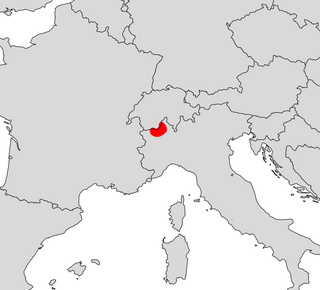
Ludovico Maria Sforza, also known as Ludovico il Moro and termed the "arbiter of Italy" by historian Francesco Guicciardini, was an Italian Renaissance nobleman who ruled as Duke of Milan from 1494 to 1499.

Ludovico Maria Enrico Einaudi OMRI is an Italian pianist and composer. Trained at the Conservatorio Verdi in Milan, Einaudi began his career as a classical composer, later incorporating other styles and genres such as pop, rock, folk, and world music.

Dictynidae is a family of cribellate, hackled band-producing spiders first described by Octavius Pickard-Cambridge in 1871. Most build irregular webs on or near the ground, creating a tangle of silken fibers among several branches or stems of one plant.

The Marquisate of Saluzzo was a historical Italian state that included parts of the current region of Piedmont and of the French Alps. The Marquisate was much older than the Renaissance lordships, being a legacy of the feudalism of the High Middle Ages.
Afrobeata is a genus of jumping spiders that was first described by Lodovico di Caporiacco in 1941. As of August 2022 it contains only three species, found only in Tanzania, Ethiopia, and on Socotra: A. firma, A. latithorax, and A. magnifica. The name is derived from "Africa" and the genus Beata.
Pseudamphidraus is an obsolete spider genus of the jumping spider family, Salticidae. Both described species have only been found in Guyana. The genus was erected by Ludovico di Caporiacco in 1947.
Ludovico is an Italian masculine given name. It is sometimes spelled Lodovico. The feminine equivalent is Ludovica.

Euscorpius is a genus of scorpions, commonly called small wood-scorpions. It presently contains 65 species and is the type genus of the family Euscorpiidae – long included in the Chactidae – and the subfamily Euscorpiinae.
Ludovico di Caporiacco was an Italian arachnologist.

Mario Castellani was an Italian comic actor, best known as the sidekick of famous comic actor Antonio De Curtis (Totò). He appeared with the latter in all his major movies, as well as many of Totò's theatre productions.
Domitius menozzii is an araneomorph spider species of the family Nesticidae. It occurs in Italy, where it can be found in caves. It was described by Ludovico di Caporiacco in 1934.

Tapinauchenius plumipes, the orange tree spider, is a tarantula endemic to French Guiana. It was first described by Ludovico Di Caporiacco in 1954. Its previous name, Tapinauchenius gigas was based on the latin word for giant, being gigas. This tarantula is kept as pets and commonly breed.

Aelurillus subaffinis is a species of jumping spider in the genus Aelurillus that lives in East Africa. It was first described in 1947 by Ludovico di Caporiacco based on a specimen that may have come from Tanzania. Only the female has been described. The spider is small. It has a dark brown carapace that is between 3.1 and 3.2 mm long and a yellow abdomen that has a length between 2.75 and 3.8 mm. It has brown chelicerae, a brown-yellow clypeus and yellow legs. The epigyne has a low pocket, distinctive shape and sclerotized flaps. It is similar to the related Aelurillus aeruginosus apart from the copulatory organs.
Neaetha catula is a species of jumping spider in the genus Neaetha that lives in East and Southern Africa. The male was first described in 1886 by Eugène Simon and the female by Ludovico di Caporiacco in 1949. First discovered in Zanzibar, examples have also been identified in Kenya. The spider is small, 3 mm (0.12 in) long, with a generally black cephalothorax and abdomen, although the abdomen has a pattern of spots towards the rear and a thin line that divides it in two. The species can be distinguished from others in the genus by the lack of central pocket in the female's epigyne. This feature led Dmitri Logunov to consider whether the spider belongs to the genus.

Leonardo is a historical drama created by Frank Spotnitz and Steve Thompson. The series was produced by Italian Lux Vide in collaboration with Rai Fiction, Sony Pictures Entertainment, with Frank Spotnitz's Big Light Productions and Freddie Highmore's Alfresco Pictures in association with France Télévisions and RTVE.
Innoxius magnus is a harvestman from the genus Innoxius and the family Stygnidae. It was first described by Ludovico di Caporiacco in 1951.

Stenaelurillus albopunctatus is a species of jumping spider in the genus Stenaelurillus that lives in Kenya. It was first described in 1949 by Ludovico di Caporiacco. The spider is medium-sized, with a cephalothorax between 2.24 and 23.55 mm long and abdomen between 2.38 and 3.92 mm long. It has two white stripes on its carapace and white speckles or spots on its abdomen. The female is generally lighter than the male. For example, the female has a brown and yellow carapace, which in the male is brown or black. The female clypeus and legs are yellow, while on the male they are brown. Otherwise, the colouration is similar to many other species in the genus. It is this similarity that led to the species Stenaelurillus guttiger being recognised as a member of the genus. The male has a spatula-like appendage at the front of its yellow pedipalps and a short thick embolus. The female has copulatory openings positioned very closely together and short insemination ducts.

Ludovico Tersigni (born 8 August 1995) is an Italian actor and television host.
Gluviema is a monotypic genus of Galeodid camel spiders, first described by Ludovico di Caporiacco in 1937. Its single species, Gluviema migiurtina is distributed in Somalia.

Alpiscorpius beta is a species of scorpion in the family Euscorpiidae. It was described by Ludovico di Caporiacco in 1950.











